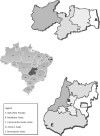Epidemiology of HIV, syphilis, and hepatitis B and C among manual cane cutters in low-income regions of Brazil
- PMID: 30390628
- PMCID: PMC6215621
- DOI: 10.1186/s12879-018-3439-4
Epidemiology of HIV, syphilis, and hepatitis B and C among manual cane cutters in low-income regions of Brazil
Abstract
Background: In recent decades the epidemic of asymptomatic sexually transmitted infections has extended deep into Brazil, including small towns and rural areas. The purpose of this study was to investigate the epidemiology of HIV, syphilis, and hepatitis B (HBV) and hepatitis C viruses (HCV), and to evaluate immunization coverage against hepatitis B in a group of rural workers in Brazil.
Methods: In 2016, a cross-sectional study was conducted with 937 manual sugarcane cutters of the Midwest and Northeast Regions of Brazil. All individuals were interviewed and screened for HIV, syphilis, HBV and HCV. Correlating factors with lifetime HBV infection were investigated using logistic regression. Positive Predictive Values, Negative Predictive Values, sensitivity and specificity were also calculated relative to vaccination against Hepatitis B, comparing anti-HBs titers to vaccination reports.
Results: Most reported previous hospitalization (55%), occupational injuries (54%), sharing of personal items (45.8%), alcohol consumption (77.2%), multiple sexual partners in previous 12 months (39.8%), and no condom use during sexual intercourse in last 12 months (46.5%). Only 0.2% reported using injection drugs. Anti-HIV-1 was detected in three individuals (0.3%). Serological markers of lifetime syphilis (treponemal test) were detected in 2.5% (95% CI: 1.6-3.6) of participants, and active syphilis (treponemal test and VDRL) present in 1.2%. No samples were positive for anti-HCV. The prevalence of lifetime HBV infection (current or past infection) was 15.9%, and 0.7% (95% CI 0.4 to 1.5) were HBsAg-positive. Previous hospitalization (OR 1.53, CI 1.05-2.24, p < 0.01) and multiple sexual partners in the last 12 months (OR 1.80, CI 1.25-2.60, p < 0.01) were predictors for lifetime HBV infection. Although 46.7% (95% CI 43.4-49.9) of individuals reported having been vaccinated against hepatitis B, only 20.6% (95% CI 18.1-23.3) showed serological evidence of previous hepatitis B vaccination (positive for anti-HBs alone).
Conclusions: The high prevalence of syphilis and HBV compared to the general population and the high frequency of risk behaviors show the potential for sexual and parenteral dissemination of these agents in this rural population. In addition, the low frequency of hepatitis B vaccinated individuals suggests a need for improved vaccination services.
Keywords: Poverty areas; Rural population; Sexually transmitted diseases; Viral hepatitis vaccines.
Conflict of interest statement
Ethics approval and consent to participate
This study was approved by the Research Ethics Committees of Brazil in Goiás and Paraíba, according to resolution CNS No. 466/12, under protocols 042796/2015 and 1,507,737/2016, respectively. All individuals who agreed to participate in the study provided written informed consent, through a signature or thumbprint.
Consent for publication
Not applicable.
Competing interests
The authors declare that they have no competing interests.
Publisher’s Note
Springer Nature remains neutral with regard to jurisdictional claims in published maps and institutional affiliations.
Figures
References
-
- Unemo Magnus, Bradshaw Catriona S, Hocking Jane S, de Vries Henry J C, Francis Suzanna C, Mabey David, Marrazzo Jeanne M, Sonder Gerard J B, Schwebke Jane R, Hoornenborg Elske, Peeling Rosanna W, Philip Susan S, Low Nicola, Fairley Christopher K. Sexually transmitted infections: challenges ahead. The Lancet Infectious Diseases. 2017;17(8):e235–e279. doi: 10.1016/S1473-3099(17)30310-9. - DOI - PubMed
-
- World Health Organization [WHO]. Global Hepatitis Report. (2017). http://apps.who.int/iris/bitstream/10665/255016/1/9789241565455-eng.pdf?.... Accessed 19 Jan 2018.
-
- World Health Organization [WHO]. HIV/AIDS Fact sheet Updated July 2017. (2017). http://www.who.int/mediacentre/factsheets/fs360/en/. Accessed 19 Jan 2018.
-
- Frew PM, Parker K, Vo L, Haley D, O'Leary A, Diallo DD, Golin CE, Kuo I, Soto-Torres L, Wang J, Adimora AA, Randall LA, Del Rio C, Hodder S, HIV Prevention Trials Network 064 (HTPN) Study Team Socioecological factors influencing women's HIV risk in the United States: qualitative findings from the women's HIV SeroIncidence study (HPTN 064) BMC Public Health. 2016;16(1):803. doi: 10.1186/s12889-016-3364-7. - DOI - PMC - PubMed
MeSH terms
Substances
Grants and funding
LinkOut - more resources
Full Text Sources
Medical
Miscellaneous


